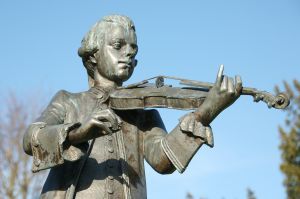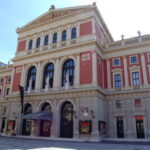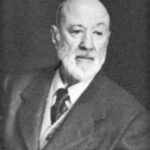The music of Wolfgang Amadeus Mozart (1756-1791) spans the years of musical Classicism. He was born when the new eclectic art was at the beginning of its prominence. His music was a true synthesis of styles, at a time of unique equilibrium between the invention and fulfillment of musical forms. During this period, Mozart completed some six hundred works in every form (symphonies, sonatas, operas, operetta, cantatas, arias, duets), and others. Mozart was a master composer of the opera, the symphony, and piano sonata, which defined musical Classicism.
Classicism was defined in a period in which the ideal was a full measure of both heart and head. A good musician required both emotional fire and intellectual skill. The breakthrough to the Classical style came just after the midpoint of the eighteenth century. It was represented by the new high-prestige group. A string ripieno with added wind instruments was called the orchestra, and the new musical type that the new group played was the symphony (Pauly 12-78).
The 1760s were the peak years for the divertimento, which was both a digression, as in the episode of a ritornello movement or a fugue, and an entertainment. The divertimento retained its relationship to the suite, being a free succession of movements, often including dances. Oratorio, strongly based on the Baroque ideal of contrast, was discontinued, along with composition for organ (an instrument incorporating the spatial concerns of the Baroque). The stylish instrument was the virtuoso harpsichord, then the piano. The piano was the ideal instrument of the new style: concise in space and capable of both a significant range of inner subtlety and a heightened surface texture that were the hallmark of the Classical style. The piano’s new instrumental form was the sonata. The opera was redefined in Classical terms (Pauly 15-78).
During the classical period, the purely theatrical was not enough, music was used to create dramatic tension. A modern form of light opera, the Singspiel, in Germany, like the earlier ballad opera in England, and the comic opera in Italy and France, presented ordinary people in ordinary settings (rather than the gods and heroes of grand opera) (Germiniani 15-78).
The Classical style made use of three basic registers-top, middle, and bottom, equally definite and able to share the three musical functions of presenting a subject, providing the harmonic structure, and offering a countersubject. Basic to the contrasts of the style was the companion contrast of attacks, manners of addressing the instruments, which is another kind of texture, a surface texture (Pauly 47-60).
In the Classical style, few notes were slurred, and these were generally couplets or two note groups, which were to be played legato. Also popular was the two-note dotted figure, either a dotted eighth plus a sixteenth or its reverse. It was a separate entity in performance, detached from what followed. Repetition and direct contrast were redefined. Repetition in the classical style was not bound to literal, sequential or decorated restatements. It could be repeated with a different rhythm or a different harmony, even within a different tonal context. It could appear in a different register without having to change its function. This repetition with variation became known as development, and this technique was the core of the Classical experiment (Eisen 89-100).
Mozart’s symphonies were examples of the pure Classical style. The fifth of the seven symphonies he wrote in 1773, Symphony in B-flat, K. 182, represents the Classical symphony. It has a unique form, developing its materials in a successful structure within the classical ideal. The work has three movements-Allegro Spiritoso, Andantino Grazioso, and Allegro. Although the opening Allegro Spirituoso uses the techniques of the Classical style it is not a typical design for a design was seen as one unique result of the application of the techniques to particular materials (Eisen, 89-100)
.
The tonal plan was a three-section one that presented stability at more than one tonal level, continued with a contrasting unstable (modulatory) section, and culminated in a recapitulation of more or all of the first section, now tonally loyal to the key of the movement. These three sections- statement, development, and recapitulation-became basic to an opening allegro movement. It could be preceded by an introduction, or followed by a coda, or both. Upon these sections are superimposed about a dozen subjects and characteristic figures, which give a rich, lively fabric to the whole. Contrast of subject was basic to the Classical style. The ideal of direct contrast is illustrated many times in the Mozart B Major Symphony. The contrasts provided variety and motivation and filled in the structural frame with materials and stable and unstable subjects to support an arching overall scheme (Eisen, 89-100)
The second movement of the Symphony uses the French rondeau form accommodated to the ideals of tonal balance. The tonal plan is based on E major. The tondeau proper can be called a theme, in innovative concept whose origin was part of the Classical achievement. The final Allegro is an energetic movement, in the same form as the rondeau, but the entire episode-rondeau-episode-rondeau-coea, as well as the opening statement of the rondeau is repeated. This symphony contains the Classical idiom of air, the clarifying and enlightening element invoked by the generally detached styles. As a whole, this symphony presents three very different movements in a balance of type of subject, techniques of form, and an overall tonal logic and listening plan. The intense opening movement is naturally followed by a less demanding, relaxed, though modern movement, and is naturally followed by a movement of simple vigor and spirits, the least intellectual and the most kinesthetic (Eisen 89-100; Germiniani 30-45).
By the beginning of the Classical period, the time was right for a definitive generation and gifted musicians such as Mozart were ready. It was now possible to learn to compose music on one’s own, through a combination of eye and ear, book study, and direct musical experience. For the public, opera entered a new and controversial phase, but for composers, the string quartet and the symphony were the forms at the cutting edge of music. The symphony carried on much of the experimentation that defined the techniques of repetition in a form concerned basically with the abstract musical elements of time and space (Eisen, 89-100)
Mozart was prominent in refining these techniques and putting them into viable structures that would prove indispensable to composers and pleasing to listeners for many generations afterwards. An abundance of sources already exists on the Classical period and Mozart. Therefore it is difficult to say what further studies should be conducted to gather more information. However, a further investigation into the “heart and head” concept of this period could be explored to learn (1) how the composers used their talents and musical techniques of the period to touch the emotions of their listeners, (2) which compositions were most representative of this “heart and head” concept, and (3) what common elements of the compositions illustrate the “heart and head” concept.
WORKS CITED
Eisen, Cliff. Mozart’s Salzburg Orchestras. Early Music 20, 1992.
Germiniani, Francesco (David Boyden, ed.) The Art of Playing on the Violin. New Jersey: Oxford University Press, 1952.
Pauly, Reinhard. Music in the Classical Period. New Jersey: Prentice-Hall, 1965.





